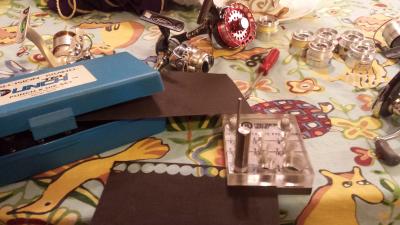To backreel or to drag….that is the question!
Back-reeling has become much more standard practice for open-water fishing, but it has its limitations on ice. First off, for bigger fish, in my opinion, you need to be fishing longer rods to absorb the wide swing of a big headshake. You’re directly atop of these fish, and back-reeling is tough if you can’t apply constant pressure to the fish via rod-blank. We’re also using smaller reels. Each turn of the reel handle gives the fish that much less line compared to open-water.
The drag option, while more widely-used for bigger fish on ice is fraught with danger however! Too much grease and your reel will get “gummy” and non-responsive when a big fish takes a big run. Even when relatively dry, cold-weather does funky things to drags, worst of all, seizing them. More often, the spool simply takes a larger amount of effort to start spinning, than to maintain its spin. Which is of course when a fish surges, breaking you off neatly.
In the past few years, fishing and filming, it seems like at least once or twice a year I meet my match. Sometimes, like last winter, more often. A fish that you either weren’t prepared to catch (i.e., pike on panfish gear), or a true giant of the species (Lake of the Woods Walleyes) makes a mockery of you as you tighten/loosen the drag, searching for the perfect mix of pressure without making the drag difficult to “start.”
I’ll hold final judgement until after the season, but in speaking with some saltwater fishermen at a baitshop in Virginia, I think I’ve got something here. Out east, and all around the world where saltwater fisherman do battle with big fish, upgraded drags are the name of the game. They dissipate heat better, but more importantly, they create a better surface for the drag to slip. Necessary when you have to make the drag “white-finger-tight”.
The best part….they’re cheap. The carbon fiber drags I bought online were about $30 shipped for 10 of them, plus grease. The next best part….they’re darn easy to install.
So, when putting on line this year, I took the chance to do some simple maintenance and upgrade those drags.
At first glance, they’re rather unimpressive. Small discs with some roughness to them.
STEP 1 – Unscrew the drag tensioner all the way and pull off the spool.
STEP 2 – Pull out the small square spring which keeps the metal drag plate in place.
STEP 3 – Pull off the drag plate and look at the small piece of felt. Because felt is very absorbent, my theory is that drag grease/oil can infiltrate the felt, and basically create a vacuum of sorts when cold weather affects the viscosity. That small piece of felt is all that saves you from burning runs of big fish. Scary!
STEP 4 – Lightly cover the carbon fiber disc with grease. The mfr. recommended Cal’s Universal Light variety. No, not Cal Svihel.  Put drag disc inside.
Put drag disc inside.
STEP 5 – Replace drag plate/washer and add spring. Install on reel and tighten down drag tensioner.
The first thing you’ll notice on your drags is how god awfully tight you can crank down on these things and still maintain relatively easy/smooth drag operation. Silky smooth. Freezer tested a dozen times or more for hiccups, herky-jerky response, or freeze/failure. Best I can figure, this is major drag upgrade for most ice reels. Especially the ones that are known for drag issues with extremely cold weather.
I upgraded the Shimano’s with Size #10301, which is the smallest carbon fiber drag for all Shimano reels. There’s lots of online retailers out there. Ebay, the web, etc. Feel free to ask any questions if this is for you, and good luck. Ice is out there, let’s fish it!
Joel





